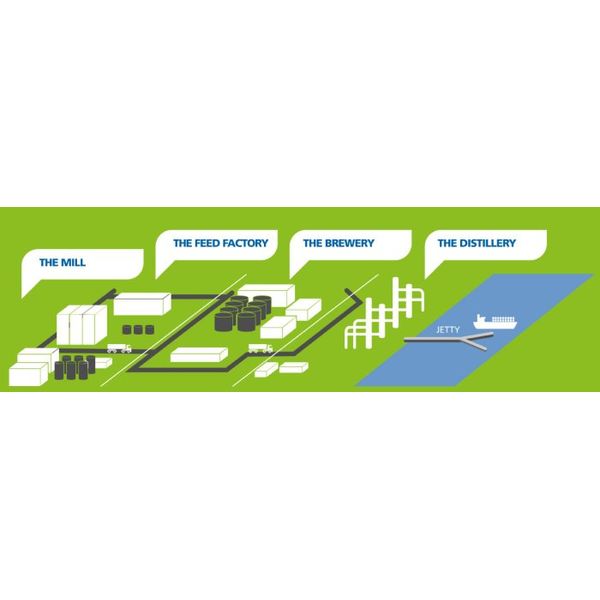

- Home
- Companies
- Vivergo Fuels Ltd.
- Products
- Vivergo - Process System
Vivergo - Process System
We will once again be one of the largest bioethanol producers in Europe, producing 420 million litres every year from early 2022 onwards. Our plant covers an area the size of 12 world cup football pitches and can produce the amount of bioethanol equivalent to 1 billion bottles of spirits every single year.
Our £350m biorefinery, based at Saltend near Hull, will use around 1 million tonnes of feed-grade wheat to produce 420 million litres of bioethanol and up to 500,000 tonnes of animal feed per year. This will make us the largest bioethanol producer in the UK and one of the biggest in Europe. We will also be the largest wheat tip in the UK and the biggest single-source suppliers of animal feed. We definitely don’t do things by halves! Once operational in early 2022, our plant will runs 24-hours a day, seven days a week. The whole process begins with locally sourced feed wheat, which is brought to our site by truck. In simple terms, our process is comprised of four key stages – The Mill, The Brewery, The Distillery and The Feed Factory. Read on to discover what happens once the wheat arrives on site…

Wheat is made up of starch, protein and fibre. At Vivergo Fuels we will use the starch to produce the bioethanol and the protein and fibre to make our animal feeds.
The process will start when the wheat arrives at the site. The wheat grains will be tested for quality and ‘tipped’ into one of our six silos, each of which can hold up to 1,500 tonnes of grain. We refer to the wheat milling and storage area of the site as ‘The Mill’, because it works in the same way as a traditional flour mill. Once the wheat has been milled into flour, it will be mixed with water to form a slurry that is then ‘cooked’ with steam. At this point the product will look a lot like thick porridge! We will then add enzymes to thin the mixture and help convert the starch into sugar before brewing.
The proteins and fibre will arrive from distillation and will be squeezed to remove most of the water. At this stage the solid product is still relatively moist. We will then transfer it to our three dryers (think tumble dryer on a massive scale) so that it can be dried and pelletised to form the majority of our animal feed product – which is similar to the food pellets you buy at a petting zoo. Some of the solid product is deliberately not sent through the dryers so that it can be sold in a moist form or as a syrup feed.
The animal feed products will be stored in a large warehouse before being delivered to farms across the UK via truck.
The porridge-like product then moves onto ‘The Brewery’, which is comprised of eight fermentation tanks and a beerwell. Here we will follow a similar process to a conventional brewery – but on an even larger scale!
We will start the brewing phase by adding yeast to the porridge-like product to convert the sugars from wheat starch to alcohol. At the end of each fermentation cycle we are left with a ‘beer’, with an alcohol concentration of around 12%. At this point, the protein and fibre from the remains is suspended in the beer solution. At the end of the brewing process the beer is transferred to the beerwell in preparation for distillation.
In the first stage of distillation we will separate the alcohol from the protein and fibre. In the second stage we will concentrate the alcohol to 96% and then further dry it to 99.7% alcohol. At this point it then becomes our bioethanol product and is sent to storage. It will then be transferred to our jetty for loading onto a ship. It will then be transported to refineries around the UK or into mainland Europe where it is blended with regular petrol for use in conventional car engines. Our process is very efficient, with virtually no waste.
